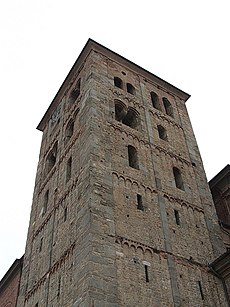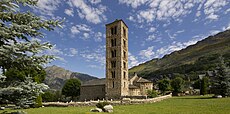First Romanesque
This article includes a list of generalreferences,butit lacks sufficient correspondinginline citations.(November 2012) |



One of the first streams ofRomanesque architecturein Europe from the 10th century and the beginning of 11th century is calledFirst RomanesqueorLombard Romanesque.It took place in the region ofLombardy(at that time the term encompassing the whole ofNorthern Italy) and spread intoCataloniaand into the south ofFrance.Its principal decoration for the exterior, bands of ornamental blind arches are calledLombard bands.It was characterized by thick walls and lack of sculpture in facades, and with interiors profusely painted with frescoes.
During the first quarter of the 11th century, much architectural activity by groups composed ofLombardteachers and stonemasons (Comacine Guild), who worked throughout much ofEuropeand Catalan territories and erected fairly uniform temples, some of which still exist today.[1]For a considerable area this process of craft diffusion started in Lombardy andLombardusbecame the word for mason at an early period.[2]One might call the First Romanesque style the style of this Italian architectural reconquest.[2]The large promoter and sponsor of this art in Catalonia wasOliva,monk and abbot of themonastery of Ripollwho, in 1032, ordered the extension of the body of this building with a façade with two towers, plus atranseptwhich included sevenapses,all decorated on the outside with the Lombardic ornamentation ofblind archesand vertical strips.
Catalan architectJosep Puig i Cadafalchsuggested that what was formerly considered the late form ofpre-Romanesquearchitecture inCataloniabore features of Romanesque and thus classified it as First Romanesque (primer romànic). The First Romanesque churches of theVall de Boíwere declared aWorld Heritage SitebyUNESCOin November 2000.
The geographical proximity of this Iberian region to the rest ofEurope,resulted in depictions of the emergingRomanesque artbeing brought to Catalonia. While the art failed to take root in the rest of theIberian Peninsulauntil the second third of the 11th century, there are numerous examples of its presence inCatalan countiesbefore this time. Though this style may not be considered fully Romanesque, the area contained many of the defining characteristics of this artistic style.
To avoid the term Pre-Romanesque, which is often used with a much broader meaning than is generally suited to refer to early Medieval andearly Christian art,and in Spain may also refer to theVisigothic,Asturias,MozarabicandRepoblaciónart forms, Puig i Cadafalch preferred to use the term "First Romanesque" or "first Romanesque art" to designate those Catalan anticipations of the Romanesque itself.
List of First Romanesque buildings
[edit]

Italy
[edit]- Lombardy
- Basilica dei Santi Pietro e Paoloin Agliate nearMonza
- Priorato di Sant'EgidioinSotto il Monte
- Basilica di Santa GiuliainBonate Sotto
- Piona AbbeynearLecco
- Santa Maria Maggiore, Lomello
- Sant'Ambrogio in Milanc. 1048
- San Michele Maggiore, Pavia
- San Pietro in Ciel d'OroinPavia
- San TeodoroinPavia
- Rotonda di San TomèinAlmenno San Bartolomeo
- Basilica of Sant'AbbondioinComo
- Basilica di San VincenzoinCantù
- Rotonda di San LorenzoinMantua
- San Vincenzo in PratoinMilan
- Emilia-Romagna
Spain
[edit]- Catalonia
- Sant Pere de Roda,founded 943, started construction c. 950
- Ripoll Monastery.Finished and consecrated in 977
- Church of Sant VicençinCardona,started in 1029 and consecrated in 1040
- Sant Cristòfol of Beget
- Sant Pere ofBesalú
- Sant Vicenç of Besalú
- Monastery of Sant Miquel, Cruïlles
- Sant Vicenç ofEspinelves
- Part ofGirona Cathedral
- Monastery of Sant Pere de Galligans inGirona
- Sant Nicolau in Girona
- Saint Cecil of Molló
- Church of Sant Joan in Palau-saverdera
- Monastery of Sant Quirze de Colerain Rabós d'Empordá
- Monastery of Sant Aniol d'Aguja
- Monastery of Santa Maria ofVilabertran
- Churches ofSaint MaryandSaint Clement of Taüll,Sant Feliu, Sant Joan de Boí, Santa Maria de l'Assumpció, Santa Maria de Cardet, la Nativitat de Durro, Ermita de Sant Quiric and Santa Eulàlia, inVall de Boí,
- Churches of Santa Maria, Sant Pere and Sant Miquel inTerrassa
- Church of Saints Just and Pastor, in Son (Pallars Sobirà)
- Huesca
- Church ofSan CaprasioinSanta Cruz de la Serós(Huesca)
- Monastery of San Pedro de Siresa (Huesca)
- Church of San Adrián de Sasave (Huesca)
- Church of Baros (Huesca)
- Church of Asieso (Huesca)
- Church of Binacua (Huesca)
- Churches of theSerrablo(Huesca), it is debatable whether they are First Romanesque orMozarab:Ordovés, Rasal,Lasieso,Arto, Isún, Satué, Lárrade, San Juan de Busa, Oliván,Orós Bajo,Susín, Basarán (now in Formigal), Otal, S. Juan de Espierre and San Bartolomé de Gavín
- Valladolid
- Nuestra Señora de la Anunciada Hermitage, inUrueña
France
[edit]- Church of Saint-Étienne, Vignory1050–1057
- St Philibert at Tournus
- Saint-Martin-du-Canigou,begun 1001
See also
[edit]- Iberian pre-Romanesque art and architecture
- List of architectural styles
- Wiligelmo
- Benedetto Antelami
References
[edit]Sources
[edit]- Armi, Edson.Orders and Continuous Orders in Romanesque Architecture.,Department of Art, University of Chicago. Oct 1975. pp. 173–188.
- Kostof, Spiro.A History of Architecture.,Oxford: Oxford University Press, 1995.
- Chueca Goitia, FernandoHistoria de la Arquitectura Española, Edad Antigua y MediaEditorial DOSSAT, 1965. Chapter:El primer arte románico.pp. 148–156.ISBN84-923918-4-7
- Chueca Goitia, FernandoHistoria de la Arquitectura occidental: Edad Media cristiana en EspañaEd. DOSSAT, 2000.ISBN84-95312-35-2
- Yarza, JoaquínArte y arquitectura en España, 500-1250Manuales arte Cátedra, 1997.ISBN84-376-0200-9
